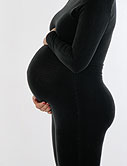Little difference in rate of spontaneous birth <34 weeks, perinatal death with use of cervical pessary
TUESDAY, Sept. 1, 2015 (HealthDay News) — For women with a twin pregnancy, insertion of a cervical pessary is not associated with a reduction in the rate of spontaneous early preterm birth, according to a study published online Aug. 27 in the American Journal of Obstetrics and Gynecology.
Kypros H. Nicolaides, M.D., from King’s College London, and colleagues examined whether insertion of a cervical pessary in twin pregnancies would reduce the rate of spontaneous early preterm birth in a multicenter randomized trial. A cohort of 1,180 eligible women were randomized to receive cervical pessary at 20+0 to 24+6 weeks’ gestation until elective removal or delivery or to expectant management.
The researchers observed no significant between-group differences in the rate of spontaneous birth <34 weeks (P = 0.722), perinatal death (P = 0.702), adverse neonatal outcome (P = 0.524), or neonatal therapy (P = 0.701). There was no benefit seen for insertion of a cervical pessary in a post hoc subgroup analysis of 214 women with short cervix (≤25 mm).
“Twin pregnancies are at substantially higher risk of early preterm birth than singleton pregnancies and this risk is inversely related to sonographically-measured cervical length at 20 to 24 weeks’ gestation,” the authors write. “Insertion of cervical pessary at around 22 weeks in both unselected twins and in those with short cervix does not reduce the rate of spontaneous early preterm birth.”
Copyright © 2015 HealthDay. All rights reserved.








